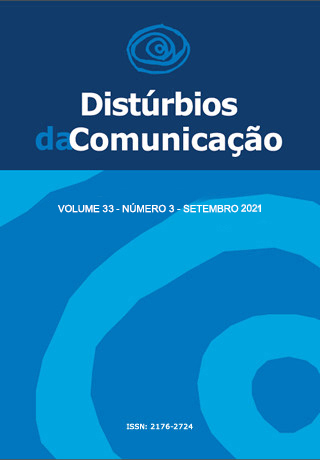Mismatch Negativity auditory evoked potentials in adult musicians
DOI:
https://doi.org/10.23925/2176-2724.2021v33i3p490-499Keywords:
Evoked Potentials Auditory, Electrophysiology, MusicAbstract
Introduction: Mismatch Negativity (MMN) is an objective exam that does not depend on the subjects’ task performance or attention. It is regularly used to study auditory processing relative to the automatic detection of auditory changes. Objective: To analyze the latencies and amplitudes of MMN in adult musicians and compare the results with those of the control group of normal hearing non-musicians. Methods: This is a cross sectional and comparative study. The sample consisted of 69 subjects, aged between 18 and 59 years, with 40 non-musician subjects (control group) and 29 musicians (study group) with at least 3 years of musical expertise, and ages over 18 years. All patients were assessed by peripheral auditory evaluation and MMN. Results: The mean latencies and amplitudes were 173.61 ms (±49.80) and 4.25μV (±3.60) in the control group, and 144.23 ms (±17.58) and 5.12μV (±2.73) in the study group. There was a significant difference between the groups per ear (p<0.05), and the mean latencies and amplitudes in the study group were 140.08 ms in the right ear and 148.37 ms in the left while the values of amplitude were 4.83μV in the right ear and 5.41μV in the left ear. Conclusion: The musicians presented better results for MMN, such as lower latency and greater amplitude, showing evidence of improved acoustic stimulus processing at the central level.
Downloads
References
Kuchenbuch A, Paraskevopoulos E, Herholz SC, Pantev C. Audio-tactile integration and the influence of musical training. PLoS One. 2014; 9(1): e85743.
Brossi AB, Borba KC, Garcia CFD, Reis ACMB, Isaac ML. Verificação das respostas do mismatch negativity (MMN) em sujeitos adultos normais. Rev Bras Otorrinolaringol. 2007; 73(6): 793-802.
Quiroga-Martinez DR, C Hansen N, Højlund A, Pearce M, Brattico E, Vuust P. Musical prediction error responses similarly reduced by predictive uncertainty in musicians and non-musicians. Eur J Neurosci. 2020; 51(11): 2250-69.
Crippa BL, Aita, ADC, Ferreira, MIDC. Padronização das respostas eletrofisiológicas para o P300 em adultos normouvintes. Distúrb Comum. 2011; 23(3): 325-33.
Sanju, HK, Kumar, R. Research Suggests New Avenues for Music Training in Aural Rehabilitation. Hearing Review. 2015; 22(8): 34.
Yashaswini L, Maruthy S. Effect of Music Training on Categorical Perception of Speech and Music. J Audiol Otol. 2020 Jul; 24(3): 140-148.
Matas CG, Hataiama NM, Gonçalves IC. Estabilidade dos potenciais evocados auditivos em indivíduos adultos com audição normal. Rev Soc Bras Fonoaudiol. 2011; 16(1): 37-41.
Perez VB, Miyakoshi M, Makeig SD, Light GA. Mismatch negativity reveals plasticity in cortical dynamics after 1-hour of auditory training exercises. Int J Psychophysiol. 2019: 145: 40-47.
Schwade LF, Didoné DD, Sleifer P. Auditory evoked potential mismatch negativity in normal-hearing adults. Int Arch Otorhinolaryngol. 2016; 20(3): 13-21.
Arndt C, Schlemmer K, van der Meer E. Same or different pitch? Effects of musical expertise, pitch difference, and auditory task on the pitch discrimination ability of musicians and non-musicians. Exp Brain Res. 2020: 238(1): 247-258
Roggia SM. Mismatch Negativity. In: Boéchat EM, Menezes PL, Couto CM, Frizzo ACF, Scharlach RC, Anastásio ART, eds. Tratado de Audiologia. São Paulo, Brasil: Santos; 2015: 151-9.
Sanju HK, Kumar P. Pre-attentive auditory discrimination skill in Indian classical vocal musicians and non-musicians. J Otol. 2016;11(3): 102-110.
Fitzgerald K, Todd J. Making Sense of Mismatch Negativity. Front Psychiatry. 2020; 11; 11: 468.
Davis H, Silverman RS. Hearing and deafness. Nova York, NY: Holt, Rinehart & Winston; 1970: 522.
Jerger J. Clinical experience with impedance audiometry. Arch Otolaryngol. 1970; 92(4): 311-24.
Kliuchko M, Brattico E, Gold BP, Tervaniemi M, Bogert B, Toiviainen P, Vuust P. Fractionating auditory priors: A neural dissociation between active and passive experience of musical sounds. PLoS One. 2019; 3;14(5): e0216499.
Crespo-Bojorque P, Monte-Ordoño J, Toro JM. Early neural responses underlie advantages for consonance over dissonance. Neuropsychologia. 2018; 117: 188-198.
Mandikal Vasuki PR, Sharma M, Ibrahim RK, Arciuli J. Musicians’ Online Performance during Auditory and Visual Statistical Learning Tasks. Front Hum Neurosci. 2017; 14; 11: 114.
Sanju HK, Kumar P. Enhanced auditory evoked potentials in musicians: A review of recent findings. J Otol. 2016; 11(2): 63-72.
Meha-Bettison K, Sharma M, Ibrahim RK, Mandikal Vasuki PR. Enhanced speech perception in noise and cortical auditory evoked potentials in professional musicians. Int J Audiol. 2018; 57(1): 40-52.
Buranelli G, Barbosa MB, Garcia CFD, Duarte SG, Marangoni AC, Coelho LMFR et al. Verificação das respostas do Mismatch Negativity (MMN) em sujeitos idosos. Braz J Otorhinolaryngol. 2009; 75(6): 831-8.
Aerts A, Mierlo PV, Hartsuiker RJ, Santens P, Letter MD. Sex differences in neurophysiological activation patterns during phonological input processing: an influencing factor for normative data. Arch Sex Behav. 2015; 44(8): 2207-18.
Ikezawa S, Nakagome K, Mimura M et al. Gender differences in lateralization of mismatch negativity in dichotic listening tasks. Int J Psychophysiol. 2008; 68(1): 41-50.
Boh B, Herholz SC, Lappe C, Pantev C. Processing of complex auditory patterns in musicians and nonmusicians. PLoS One. 2011; 6(7): e21458.
Brown CJ, Jeon EK, Driscoll V, Mussoi B, Deshpande SB, Gfeller K, Abbas PJ. Effects of Long-Term Musical Training on Cortical Auditory Evoked Potentials. Ear Hear. 2017; 38(2): e74-e84.
Vuust P, Brattico E, Seppanen M, Näätänen R, Tervaniemi M. Practiced musical style shapes auditory skills. Ann N Y Acad Sci. 2012; 1252: 139-46.
Tang W, Xiong W, Zhang Y, Dong Q, Nan Y. Musical experience facilitates lexical tone processing among Mandarin speakers: Behavioral and neural evidence. Neuropsychologia. 2016; 91: 247-53.
Nichols ES, Grahn JA. Neural correlates of audiovisual integration in music reading. Neuropsychologia. 2016; 91:199-210.
Amemiya K, Karino S, Ishizu T, Yumoto M, Yamasoba T. Distinct neural mechanisms of tonal processing between musicians and non-musicians. Clin Neurophysiol. 2014; 125(4): 738-47.
Lappe C, Lappe M, Pantev C. Differential processing of melodic, rhythmic and simple tone deviations in musicians and MEG study. NeuroImage. 2016; 124(Pt A): 898–905.
Downloads
Published
Issue
Section
License
Copyright (c) 2021 Lissandro Werlang do Nascimento, Laura Flach Schwade, Dayane Domeneghini Didoné, Pricila Sleifer

This work is licensed under a Creative Commons Attribution 4.0 International License.









